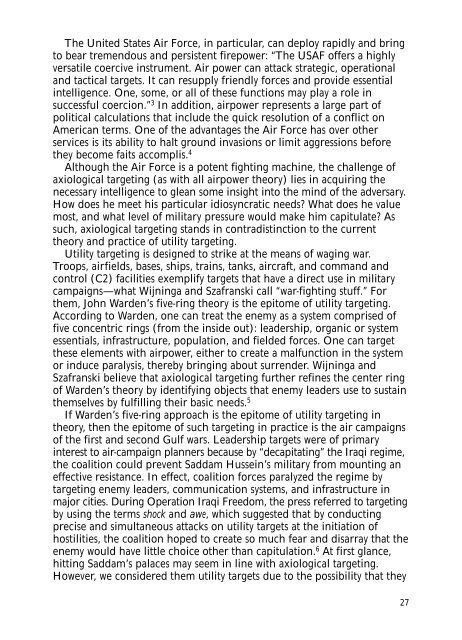presentation departments reproduced
Spring 2004 - Air and Space Power Journal - Air Force Link
Spring 2004 - Air and Space Power Journal - Air Force Link
- No tags were found...
You also want an ePaper? Increase the reach of your titles
YUMPU automatically turns print PDFs into web optimized ePapers that Google loves.
The United States Air Force, in particular, can deploy rapidly and bring<br />
to bear tremendous and persistent firepower: “The USAF offers a highly<br />
versatile coercive instrument. Air power can attack strategic, operational<br />
and tactical targets. It can resupply friendly forces and provide essential<br />
intelligence. One, some, or all of these functions may play a role in<br />
successful coercion.” 3 In addition, airpower represents a large part of<br />
political calculations that include the quick resolution of a conflict on<br />
American terms. One of the advantages the Air Force has over other<br />
services is its ability to halt ground invasions or limit aggressions before<br />
they become faits accomplis. 4<br />
Although the Air Force is a potent fighting machine, the challenge of<br />
axiological targeting (as with all airpower theory) lies in acquiring the<br />
necessary intelligence to glean some insight into the mind of the adversary.<br />
How does he meet his particular idiosyncratic needs? What does he value<br />
most, and what level of military pressure would make him capitulate? As<br />
such, axiological targeting stands in contradistinction to the current<br />
theory and practice of utility targeting.<br />
Utility targeting is designed to strike at the means of waging war.<br />
Troops, airfields, bases, ships, trains, tanks, aircraft, and command and<br />
control (C2) facilities exemplify targets that have a direct use in military<br />
campaigns—what Wijninga and Szafranski call “war-fighting stuff.” For<br />
them, John Warden’s five-ring theory is the epitome of utility targeting.<br />
According to Warden, one can treat the enemy as a system comprised of<br />
five concentric rings (from the inside out): leadership, organic or system<br />
essentials, infrastructure, population, and fielded forces. One can target<br />
these elements with airpower, either to create a malfunction in the system<br />
or induce paralysis, thereby bringing about surrender. Wijninga and<br />
Szafranski believe that axiological targeting further refines the center ring<br />
of Warden’s theory by identifying objects that enemy leaders use to sustain<br />
themselves by fulfilling their basic needs. 5<br />
If Warden’s five-ring approach is the epitome of utility targeting in<br />
theory, then the epitome of such targeting in practice is the air campaigns<br />
of the first and second Gulf wars. Leadership targets were of primary<br />
interest to air-campaign planners because by “decapitating” the Iraqi regime,<br />
the coalition could prevent Saddam Hussein’s military from mounting an<br />
effective resistance. In effect, coalition forces paralyzed the regime by<br />
targeting enemy leaders, communication systems, and infrastructure in<br />
major cities. During Operation Iraqi Freedom, the press referred to targeting<br />
by using the terms shock and awe, which suggested that by conducting<br />
precise and simultaneous attacks on utility targets at the initiation of<br />
hostilities, the coalition hoped to create so much fear and disarray that the<br />
enemy would have little choice other than capitulation. 6 At first glance,<br />
hitting Saddam’s palaces may seem in line with axiological targeting.<br />
However, we considered them utility targets due to the possibility that they<br />
27
















